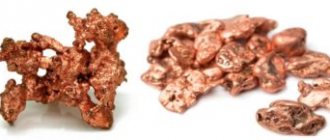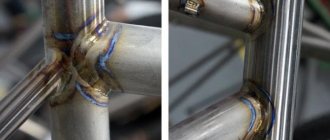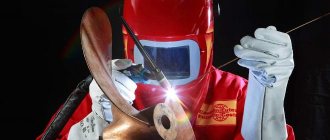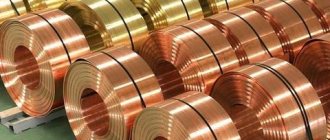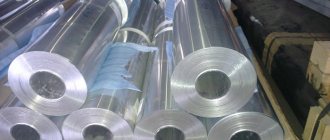Alloys created on the basis of copper have similar properties and external features. For this reason, metals are often confused. The greatest difficulties arise when it is necessary to distinguish bronze from brass. Alloys have many brands and modifications, which often coincide even in color and characteristics. It is rarely possible to identify the type of metal by external signs. When comparing brass and bronze, differences must be sought in the composition of the alloys. To study the physicochemical properties, special equipment is required, but there are ways to determine the composition at home.
What is more expensive, brass or bronze?
The cost of metals on the market is almost the same. In some collection points the price of bronze may be higher than brass alloys, in others it’s the opposite. If you want to know the cost, go to the "Sell Scrap Brass" section. Considering the average market value, we can note:
- Increased demand for brass. This metal is more often used for the manufacture of household products, plumbing equipment, pipes and other common goods.
- Components. Brass alloys are mainly made using zinc, bronze alloys - with tin and a number of other additives.
- Characteristics. With properties and physico-chemical data it is more difficult. Here the parameters depend on the percentage of copper content and additional components.
Considering these factors, the demand and composition of brass metals is more in demand, therefore the average price of this metal is 10–20 rubles per kg higher than that of bronze scrap.
The essence of materials
These metals are widely in demand today in the industrial sector. The color of brass and bronze of individual brands may be similar. However, they may differ in some of their properties. Bronze has been used by people for many thousands of years. Initially, bronze alloys were made, based on tin and copper. The metallurgical industry gradually developed, and people learned to exchange tin for other elements, such as iron, for example, or lead. Silicon, aluminum or beryllium and phosphorus could also serve as worthy alternatives. Depending on which basic materials were used, bronze can be:
What is stronger, brass or bronze?
When comparing maximum permissible loads, wear resistance and other parameters, it is important to consider that the characteristics are affected by the composition of the alloys. For comparison, it is worth taking the highest grade metals. This will help you find out how brass differs from bronze in terms of physical and chemical parameters. Having studied the data, you can note:
- Bronze is heavier. The reason is the presence of tin. Its mass is greater than that of zinc.
- The corrosion resistance of brass is lower. Bronze can come into contact with salt water with little or no effect, but brass alloys must be alloyed to reduce the effects of corrosion.
- The wear resistance of bronze products is higher, since the metal has a lower coefficient of friction.
Based on these properties, it can be noted that bronze is stronger than brass when considering equally high-quality alloys.
Comparison criteria
Despite the fact that in metallurgy there are clear criteria for distinguishing these two alloys, in real life an uninformed person is unlikely to accurately identify them.
Compound
Clear differences between metals can be traced only if the alloys do not contain impurities. However, now there are a large number of their varieties, which makes identification difficult. Brass is designated by the letter “L”; subsequent symbols in the marking indicate the presence of the main elements and the average copper content as a percentage. For example, L70 means 70% Cu content, and LAZ60-1-1 consists of 60% copper, 1% aluminum and 1% iron.
In a brass alloy, copper is combined with zinc, which gives the metal ductility and a low degree of wear resistance. This is the main additional element, but brass can be two-component or multi-component. There are different types of it.
- Deformable alloys. They are used in the production of machine parts, pipes, and springs.
- Foundries. Bearings, fittings, and devices designed to operate in conditions of elevated temperatures and aggressive environments are made from them.
- Jewelry brass. It is used to make jewelry, medals, decorative elements, and art products.
In bronze, copper is alloyed with tin, which makes the metal stronger, stronger and more durable. But sometimes aluminum, beryllium or magnesium are used instead. There are also several types of bronze.
- Tin bronze, also known as “bell” bronze. The main alloying element is tin. The alloy has good corrosion resistance and high anti-friction properties.
- Tin-free alloys. They use other components (aluminum, lead, beryllium, silicon and the like). These alloys are much softer and more ductile. The color of the material depends on the components it contains. For example, aluminum bronze has a distinctive golden-yellow color, which is why it has long been used as a substitute for gold in the production of coins and jewelry.
The most famous of the tin-free alloys is constantan. This heat-stable metal with high resistivity contains copper (about 59%) with the addition of nickel (39-41%) and manganese (1-2%).
By the way, the markings of bronze alloys do not indicate the percentage of copper, it is calculated. For example, BrA9Zh3L contains aluminum – 9% and iron – 3%. The letters “Br” mean bronze, and “L” means foundry.
Appearance
Due to its high zinc content, brass is similar in color to real gold. However, the shade directly depends on the percentage of a particular chemical element. Therefore, the spectrum of colors can vary from pink-red to golden yellow. Typically, brass appears as a yellow-golden metal.
A bronze alloy has a silvery-white tone if it contains more than 35% tin. If its content reaches 40%, then the color of the metal is closer to white, reminiscent of steel. Products made from such bronze have a silver color with a light golden tint. If the composition contains a large proportion of copper (more than 85%), then the color of this metal is closer to red or dark brown.
Properties
Brass needs to improve its qualities, so various additional components are introduced into the alloy. Thanks to this alloying, the cast brass alloy is characterized by resistance to corrosion, low coefficient of friction, increased fluidity, low tendency to segregation, and excellent technological and mechanical properties.
Bronze has high strength properties and a low coefficient of friction. Due to its excellent resistance to the negative effects of aggressive environments, the metal is widely used in shipbuilding and shipping. Copper alloy has a wide range of applications - from decorative interior elements to critical parts.
Weight and strength
Brass is a more fragile and less durable material, prone to rapid wear. It is not used where high abrasion resistance is required. Due to the low density of zinc, brass is much lighter than bronze. Bronze is a wear-resistant and durable material. Due to its ductility, it is a favorite casting alloy for sculptors. It is much harder and stronger than brass. For example, a metal with 27% tin content is extremely hard, heavy and brittle. That is, the hardness of bronze depends on the percentage of tin in it. But this statement cannot apply to tin-free alloys.
More accurately, the specific gravity can be calculated by multiplying the density of the metal by the volume of the workpiece.
Visual differences
What does brass look like? It is often identical to bronze. If you do not consider alloys as a whole, but take grades of metals with significant differences, then the type of alloy can be identified visually. This does not apply to tactile sensations. External signs are:
- weight - with the same dimensions, bronze products are heavier;
- color - brass products have a yellowish tint with a fine-grained texture.
These are the only ways to differentiate by species. If the external characteristics of the metals are similar, a more complex method will be required.
How to distinguish at home?
In practice, there are several simple and proven methods to help identify metals.
How to distinguish bronze from brass using a magnet?
- When it comes to a variety of alloys, it can be quite difficult to distinguish bronze from brass, because they can be almost identical. Many experts believe that bronze is heavier than brass. This is indeed due to the content of tin and lead, which are quite heavy.
- Brass is much lighter due to the presence of zinc. You can conduct a few simple experiments to find out which metal is in front of you. Bronze is almost always magnetic due to the presence of tin.
- That is, if you apply a strong enough magnet, you will see significant magnetization. The higher the tin content in the metal, the stronger the magnetization. Brass, in turn, does not exhibit magnetic properties, that is, when a magnet is placed, it does not stick at all.
Heat treatment
If you have equipment that can create temperatures in the range of 600-650oC, you can determine the alloy by heating the metal. The method is used to influence brass products - the metal contains zinc.
How to determine brass or bronze? Under the influence of high temperature, zinc begins to oxidize, which leads to the formation of oxide on the surface of the brass product. The resulting coating has an ashen tint, which cannot form on bronze items under the influence of temperatures. After heat treatment, the brass alloy will become more ductile. The product will not break under heavy loads.
The thermal method is used for brass alloys based on zinc. If the alloying component is another metal, the test will not give the desired result.
Comparative characteristics
When choosing a specific alloy, it is recommended to consider the following:
- The main alloying component of bronze is tin, and that of brass is zinc. Moreover, both metals are made on the basis of copper.
- Bronze resists the influence of external factors better.
- Bronze products have a dark brown tint and a coarse-grained structure. Brass is characterized by a yellow-golden color and fine grain.
Bronze and brass are similar alloys made from copper. Moreover, they contain different alloying components. This affects the properties and structure of metals.
Chemical method of determination
This method is the most reliable for identifying the type of alloy. However, the metals are destroyed during the reaction, so small parts of the complete product must be used for the experiment. You will also need nitric acid, which is dangerous to work with. The whole process is divided into stages:
- part of the metal breaks off from the products;
- mix water and nitric acid - 1 to 1;
- the metal is placed in the prepared solution;
- the reagents are heated to boiling temperature;
- it is necessary to maintain a boil over the fire until the metal is completely dissolved.
Next, you need to visually inspect the solution. If brass was placed in the reagent, the liquid will remain clear. Dissolved bronze will not disappear, but will contribute to the formation of a white precipitate.
The disadvantage of this method is that the bronze alloy requires tin. It is this metal that gives the white precipitate.
Why was zinc added to copper and why are zinc statues not cast?
Copper is alloyed with zinc to create alloys with properties that copper and zinc do not have individually. Copper is a good conductor of heat and electricity. Copper is ductile, stretches, and can be stamped. Copper wires, copper tubes for refrigerators, heaters or air conditioners, copper utensils fully realize the properties of copper, such as heat and electrical conductivity, and high ductility. Corrosion resistance and chemical inertness to household solutions make it possible to produce copper cookware, frying pans, and pots. But the downside of the properties of copper is that it has insufficient strength, hardness, corrosion resistance and high cost for widespread use in technology as a structural material. For five thousand years, people have been modifying copper by adding other metals to the melt to measure its properties.
We carry out spectral analysis
If you have tried all the methods, but have not found an option on how to distinguish bronze from brass, it is worth conducting a spectral analysis. This method is carried out using high-tech equipment that accurately determines the composition of the alloy. This is the only way to guarantee correct detection of brass or bronze. Under the influence of radiation, the devices examine the spectrum of materials used to create the metal. The type of radiation is electromagnetic waves.
Such devices are difficult to rent and expensive to purchase. To carry out an analysis, you should contact scrap metal collection points. Our company conducts a free analysis to determine the cost of scrap before purchasing. Before handing over scrap, find out the prices for receiving bronze. We guarantee accurate results and correct payments.
General characteristics of metals
Bronze and brass are metal alloys that are made from copper. The difference between these substances is the alloying material. This is reflected in the characteristics of the alloys. As a result, the scope of their use differs.
Bronze is understood as a copper-based alloy containing alloying substances such as silicon, beryllium, and tin. In addition, the composition may contain lead and aluminum. It is also possible to use other ingredients - nickel or zinc. In this case, the alloy is called spiater. It has a lower cost, but is also inferior in physical parameters.
Brass is an alloy of copper and zinc. The composition may also contain other ingredients - lead, tin, iron. Sometimes it contains manganese, nickel and other components. Brass is characterized by a fine-grained structure, which is why it is actively used in industry.
Today, steel-brass bimetal is often made. It is characterized by a high degree of resistance to corrosion and physical wear. In this case, the substance is considered to be quite plastic and can be easily cast.
Brass bushing
The brass bushing is a symmetrical part in the shape of a cone or cylinder. The axial hole in the bushing serves to place part of the mating element inside it.
Characteristics
Brass bushings are produced from copper-zinc alloys: L68, L63, LAZ60-1-1, LS59-1, LK80-3L, LK, LO, LMTSS, LS, LTs40S, etc.
Alloy L63 LS59-1 LTs16K4 LTs40S
Density, kg/m³ 8440 8500 8300 8500
Metal hardness 150-160 150-160 100 70
according to Brinell, MPa
Temporary resistance 380-450 300-400 343 215
rupture, MPaRel. elongation 40-50 40-50 15 20 after rupture, %
Brass alloys are two-component materials consisting primarily of copper and zinc. Alloying elements are often added to the alloys, which give the brass grades special, unique properties. By analogy, such alloys are called special.
Brass bushings are made in metallurgical plants. Their sizes, depending on the purpose of the finished product, vary significantly. Thus, the diameters of manufactured bushings can vary from 35 mm to 1 m or more.
The bushing, as an element of a machine or mechanism, helps to extend the service life of the entire unit and significantly reduces the possibility of its breakdown.
The bushing, made of brass, is less durable than the main parts of the mechanism. Being exposed to friction, it wears out faster, thereby maintaining the integrity of the remaining structural elements.
Advantages of brass bushing as parts:
— high strength of the metal, which determines the long service life of the product;
— high resistance to friction and corrosion;
- low cost compared to bronze analogues.
Thus, brass is cheaper and more durable than copper and bronze. These qualities make her in demand.
Often, brass bushings are used as universal-purpose sliding bearings, providing an optimal balance of affordability, quality and functionality.
Bearings can be subjected to sufficient loads without destruction, and if they fail, they do not damage other parts of the mechanism. They have high anti-friction parameters and operate in a wide range of temperatures.
Suitable for modes: high load - low speed, low load - high speed.
Bushing LS59-1
In addition to 0.75% impurities, the composition of brass LS59-1 includes:
— copper — from 57 to 60%;
— zinc — from 37 to 42.2%;
— lead — from 0.8 to 1.9%.
Lead and zinc, acting as alloying additives, improve the physicochemical properties of the alloy. Among brass subjected to pressure treatment, grades L63 and LS59-1 are leaders in terms of volumes of use.
The positive qualities of these materials are:
— relatively low price;
— hardness combined with good machinability;
— high anti-friction and anti-corrosion properties.
The LS59-1 bushing is successfully used in various industrial sectors. In particular, it is used for the production of bushings for those machines on which it is then processed.
Bushing LC
In addition to 2.5% impurities, the composition of LC brass includes:
— copper — from 76 to 81%;
— zinc — from 12 to 21.2%;
— silicon — from 2.8 to 4.5%.
In addition, the alloy contains nickel, iron, lead, antimony, manganese, phosphorus, tin and aluminum.
The production method for LC bushings is casting. In this way, not only bushings are made, but also parts of more complex shapes that are used in sea water: gears, elements of friction units. The LC alloy has a low coefficient of friction combined with good machinability.
Production
The chemical composition of brass bushings is determined by GOST 15527-2004. The dimensions of copper products (and brass in particular), as well as permissible deviations, are determined by GOST 4379-2006.
It replaced the standards: GOST 1978-81, GOST 24832-81, GOST 29201-91. The foundry method for producing brass bushings is centrifugal casting.
This is the main method aimed at producing high-quality castings of any, even very complex, configuration. It is used along with earth casting and chill casting.
The centrifugal casting operation is based on filling a mold with molten metal in a certain direction, taking into account the action of centrifugal forces.
The resulting casting is high-strength throughout its entire volume and does not contain shells or slags. Centrifugal casting technology makes it possible to obtain high-quality bushing blanks, the further processing of which is minimized, which significantly reduces the cost.
In order for the workpiece to become an element of a machine or mechanism, milling, internal diameter boring and grinding operations are performed.
Non-ferrous metal produced by centrifugal casting has a fine-crystalline structure. It is durable, wear-resistant and inexpensive.
Bushing selection
The grades of alloys that are used to make brass bushings differ in their chemical and mechanical properties. The chemical composition of the alloy determines its mechanical characteristics. This must be taken into account when choosing finished products.
The price depends on the size and type of product. When choosing bushings, the customer needs to pay attention to such characteristics as:
— speed and temperature conditions;
— aggressive work environment;
— intensity of the “start-stop” mode;
— intensity of oscillatory movements;
— the value of the hardness of the bushing material in relation to the other parts of the assembly;
— frequency of lubricant supply.
Depending on the purpose of the machine unit, bushings are divided into fixing, transition, connecting, bearings, etc.
Bushing bearings are used most often. Such parts are made from alloys with high anti-friction properties. This is done to improve the performance of the bushing/axle or bushing/trunnion assembly as a whole.
The adapter sleeve is used to mate parts of different diameters into a rotating assembly. Example: mating a spindle of a larger diameter with a drill of a smaller diameter through an adapter sleeve. An adapter sleeve is used to fix the inner rings of bearings on a shaft or on an axle.
According to their appearance, they are divided into cylindrical, composite, threaded, conical and split bushings. Cylinder and cone shaped bushings account for up to 90% of the total number of parts used.
In addition, brass bushings are also classified according to the following indicators:
— overall dimensions of the finished product (the value of the internal and external diameter, length);
— brand of alloy from which the brass bushing is made;
— types and availability of additional processing.
Application
Brass bushings are distinguished by wear resistance, strength, elasticity and resistance to aggressive operating conditions. These qualities are necessary for the operation of machines and mechanisms:
— in the industrial industry (here these are parts of equipment for stamping and forging, rolling mills, hydraulic presses);
— in the mining industry (parts of units of mining excavators, coal combines, crushers);
— railway transport (bushings play the role of liners in the bearings of locomotive motor-axle pairs);
— in the production of heavy-duty transport;
— in hydropower engineering (in the working units of hydraulic turbines of various types).
In addition, almost no household electrical appliance can do without brass bushings. This could be a blender, washing machine or hair dryer. The service life of these products directly depends on the quality of the brass bushings used for their manufacture.
Supplier : LLC RTG "MetPromStar"
Heating
A reliable way to distinguish brass from bronze is heat treatment, namely, heating the metal to a temperature of at least 600-650 °C. Wherein:
- the bronze workpiece will heat up and then cool down without visible changes in the color of the material and its mechanical properties. Bending such a product more often causes its destruction;
- in the brass sample, oxidation of zinc will occur, as a result of which the surface will be coated with a coating with an ashen tint. In addition, the part will become plastic and, when bent, will not lose the integrity of its structure.
The only problem is to find equipment that can create the temperature effect at the required level.

